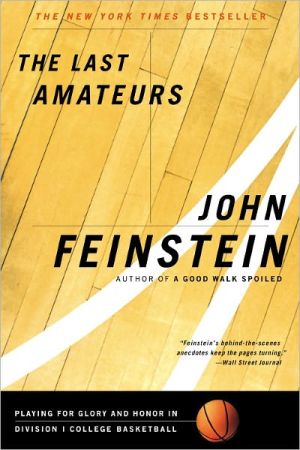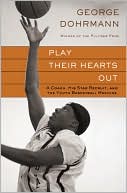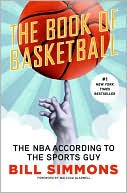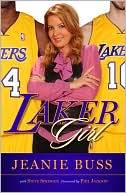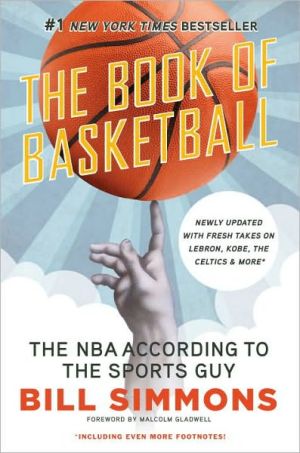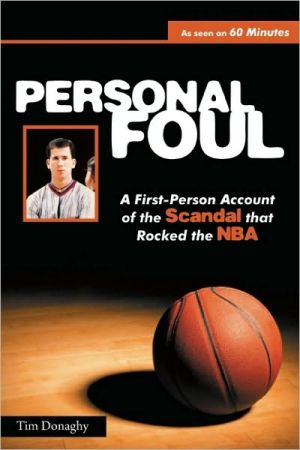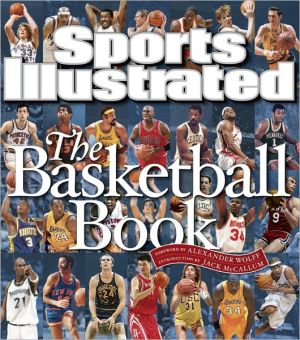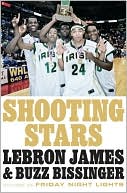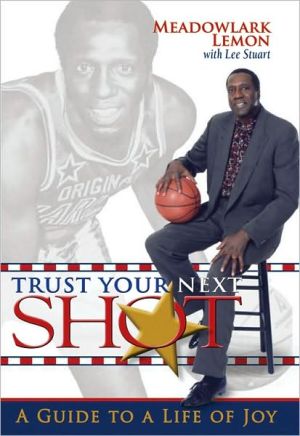Last Amateurs: Playing for Glory and Honor in Division I College Basketball
Like millions who love college basketball, John Feinstein was first drawn to the game because of its intensity, speed and intelligence. Like many others, he felt that the vast sums of money involved in NCAA basketball had turned the sport into a division of the NBA, rather than the beloved amateur sport it once was. He went in search of college basketball played with the passion and integrity it once inspired, and found the Patriot League. As one of the NCAA's smallest leagues, none of these...
Search in google:
Like millions who love college basketball, John Feinstein was first drawn to the game because of its intensity, speed and intelligence. Like many others, he felt that the vast sums of money involved in NCAA basketball had turned the sport into a division of the NBA, rather than the beloved amateur sport it once was. He went in search of college basketball played with the passion and integrity it once inspired, and found the Patriot League. As one of the NCAA's smallest leagues, none of these teams leaves college early to join the NBA and none of these coaches gets national recognition or endorsement contracts. The young men on these teams are playing for the love of the sport, of competition and of their schools. John Feinstein spent a season with these players, uncovering the drama of their daily lives and the passions that drive them to commit hundreds of hours to basketball even when there is no chance of a professional future. He offers a look at American sport at its purest. Entertainment Weekly ...makes you care about the little-known players of the Patriot League...you'll be glued to the page...
1\ ONE SHINING MOMENT\ ON a frigid March day, in the quiet of a near-empty field house, the members of the Lafayette College basketball team went through the routine one last time. For four days they had prepared and re-prepared and prepared again to play Temple in the opening round of the NCAA basketball tournament. In all, there may not have been a soul outside of the twenty people inside the Canisius College gym that morning who gave them any chance to win the game. Temple was ranked fifth nationally and many were picking the Owls to reach the Final Four. They were the number two seed in the Eastern Regional.\ Lafayette was the number fifteen seed. According to the computer rankings that the tournament selection committee uses as a guide in seeding the sixty-four-team field, it was the 126th-ranked team in the country. Among the thousands filling out brackets in office pools, the number of people picking Lafayette to win the game could probably be counted on one hand - with fingers to spare.\ Temple's most impressive victory of the season had been an upset of top-ranked Cincinnati - at Cincinnati - on national television in February. Lafayette's most impressive victory of the season had been a 26-point rout of 131st-ranked Navy in the Patriot League Tournament championship game a week earlier. That victory had put the Leopards into the NCAA Tournament and created the matchup with the powerful Owls.\ But in the small Canisius gym, the notion that tiny Lafayette could upset Temple was a living, breathing thing. The players and coaches understood their role in the grand scheme of the event. They were supposed to be fodder. A day earlier in the Buffalo newspaper they had read a story in which Ian Eagle, who would do play-by-play on the game for CBS, had explained that he would do extra research for the Temple-Lafayette game because there was a good chance he would need a lot of fill material once Temple pulled away.\ Their coach, Fran O'Hanlon, whose soft-spoken manner hid a deep-seated competitive streak, had reminded them again and again that, as good as Temple was, as much as he respected Coach John Chaney, they were beatable. It would not be easy, but it was far from impossible.\ "Remember one thing," O'Hanlon told his players during a brief break in the pregame workout. "No one will work harder than you. No one will want to win more than you. No one deserves to be here more than you."\ They looked him right in the eye as he spoke, his voice, as always, just loud enough to be heard. They nodded in agreement. There would be close to 20,000 people in the Marine Midland Arena that afternoon. Only twice all season - at a tournament in New Mexico - had they played in an arena that seated more than 10,000 people. Those games had been played before a lot more empty seats than people. Now, they would be playing in a huge, packed arena. The CBS telecast would only go to a small portion of the country unless Lafayette was in a position to win. Then, a producer in New York would order a switch flipped and the entire country would be watching Lafayette.\ It was a quiet practice. There was very little of the usual joking and ribbing. The previous day, several players had received prank phone calls in their hotel rooms from someone claiming to be a reporter from the Buffalo News. The consensus was that the prankster had been Brian Ehlers, the two-time Patriot League player of the year whose deadpan manner belied a mischievous streak. But that time had now passed. In a few minutes, they would leave the empty gym behind. The packed arena and the Owls loomed.\ When he had put them through their final paces, going over Temple's personnel one last time, walking through the offensive sets they would use against Temple's infamous matchup zone defense, reminding them again and again how important communication would be from the game's first minute, O'Hanlon called them all to the center jump circle.\ "Okay, guys," he said, his voice soft as ever, but filled with the firmness all the players understood to mean he wanted complete attention. "There's nothing they're going to do we haven't prepared for. You know that. We just have to be ready to play from the first minute. Not the fifth or the tenth, the first. Everybody understand?"\ They all nodded. They all understood. There was no margin for error in this game. They had developed a penchant early in the season for dropping behind teams in the early minutes of games. Most of the time, they had been able to recover because they were a smart, experienced team that didn't panic. Against a team like Temple all the smarts and experience in the world wouldn't be enough if they fell into an early hole.\ O'Hanlon held their gaze for a moment, then stepped into the middle of the circle with his hand in the air. "Okay then, let's get it in."\ They all stepped into the circle, surrounding him, each with his right arm in the air, leaning against one another with the natural closeness that comes with being a team. "On three," O'Hanlon said. They waited three counts and then, as one, said simply, "Leopards!" the word bouncing off the empty gym's walls.\ As they separated and began making their way to the benches where the sweats lay that they would put on before venturing into the subfreezing Buffalo morning, Rob Worthington, a six-six sophomore from St. Paul, Minnesota, the youngest of the five starters, looked at Alan Childs, the team's faculty representative, and Dawn Schleiden, the trainer, with a gleam in his eyes. Pointing to the clock on the wall that read a few minutes before eleven o'clock, he said, "Four hours until we shock the world."\ They had to wait an extra fifteen minutes. O'Hanlon had gone through his pregame talk, trying to time it so that his last words would be spoken just as the first game of the afternoon doubleheader was ending. Locker room number six in the Marine Midland Arena, the one that had "LAFAYETTE" printed in large blue letters on the door, was about five times the size of the locker room the players dressed in at home. In one corner was a television set. When O'Hanlon finished, someone turned the TV on to check the status of the Oregon-Seton Hall game. There were less than ten seconds left and Seton Hall had the ball, trailing by 2. The players watched in silence, wanting to know if the game was going to end or go to overtime.\ It went to overtime. A Seton Hall senior named Rimas Kaukenas hit a short jumper just before time expired. The noise from the arena could be heard through the television and through the back wall of the locker room, since the playing floor was no more than fifty feet beyond the wall. The players, all of them standing in anticipation of taking the floor to warm up, sat down, knowing they would have to wait out the extra five minutes.\ O'Hanlon grimaced for a moment. The only thing worse than waiting for a game to start, especially a big game, is waiting an extra fifteen minutes for a game to start. "Relax, fellas," he said. "Watch the overtime."\ Then he walked down the hall and out to the court to watch from there. Players are always looser when their coach isn't in the room. O'Hanlon had been a player long enough to remember that. So, he gave them some extra space. As the overtime clock wound under a minute, he turned to walk back to the locker room. At the entrance to the hallway where the locker rooms were located, a security guard stopped him.\ "Sir, I need to see your pin."\ At the NCAA Tournament, each member of a team's official party is given a lapel pin - a new one with a different color for each day - that grants him access to the locker room area. O'Hanlon had stuck his in his pocket. Now he fished through his pockets for it, even as someone was explaining to the security guard who O'Hanlon was. Finally, O'Hanlon produced the pin. The security guard was less than impressed.\ "You're supposed to be wearing it," he said.\ O'Hanlon said nothing, although a number of different responses crossed his mind. Once he was safely in the hallway he smiled and said, "I'll bet John Chaney doesn't need his pin."\ By the time he reached the locker room, the clock was under ten seconds again. This time Seton Hall had the ball, down by 1. Point guard Shaheen Holloway sprinted the length of the court, ducked between defenders and threw a desperate shot toward the rim. The ball kissed high off the glass and dropped through the net. The cheers came out of the TV and through the wall again. Seton Hall had won, 71-70.\ The television was shut off as soon as the buzzer sounded, and the players gathered around O'Hanlon. "This is a day we're all going to remember the rest of our lives," he said. "Let's make it a special memory."\ They formed their huddle around the coach one more time, said the Lord's Prayer, and then walked down the hallway and into the bright lights of the massive arena. They took the floor at almost the same instant that Temple did, each school's pep band trying to drown the other out. It is a rule of basketball that you don't stop and watch your opponents during warm-ups, but every once in a while there was a stolen glance, a quick look. What the Leopards saw wasn't so much scary as sobering. Even in their warm-ups, the Owls looked huge.\ Suddenly, Stefan Ciosici, Lafayette's six-eleven, 260-pound center - nicknamed "Boogie" by his teammates because "he's bigger than the boogie man" - didn't look quite so huge. Not when Temple trotted out Ron Rollerson, at six-ten and at least 300 pounds, as well as six-ten, 250 Lamont Barnes and six-ten, 250 Kevin Lyde. Worthington would be the second biggest Lafayette starter at six-six, 215.\ Size doesn't always guarantee success in basketball, but Temple had the whole package: size, quickness, experience, and shooters. The players had known that on Sunday night when they had gathered to watch the pairings announced on CBS, but now they could see it firsthand. They had known this would not be easy; now they could see exactly why.\ Even so, they weren't intimidated. They had been in the NCAA Tournament a year earlier and faced another number two seed, Miami. For twenty-five minutes, they had hung with the Hurricanes, until their size and strength wore them down; the final score had been 75-54. They had played good teams during the season just past: Georgia Tech, Villanova, Penn, Princeton - all on the road. They had beaten Princeton in overtime. They had lost in the final seconds to Villanova and Penn. They had hung close to Georgia Tech before losing by 11. They knew Temple was better than any of those teams. But this was March. They were better now than they had been early in the season. And this was a neutral court, a court where they assumed - hoped - the crowd would be for them if the game stayed close because they were such overwhelming underdogs.\ It was 3:15 in the afternoon when they walked onto the court for tip-off. They were listed as a 21-point underdog. That was fine with them. They were ready to shock the world. At a couple of minutes after four, they made the walk back down the hallway. This time, no one asked O'Hanlon for his pin. His response if he had been stopped might not have been as calm as it had been earlier.\ The halftime score was 38-20. Lafayette had the 20. O'Hanlon didn't even feel as if his team had played poorly. It had simply been overmatched. Lafayette's only realistic hope had been to catch Temple on a day when its outside shooters were off the mark. Mark Karcher, their top 3-point shooter, had started the game by making three shots from beyond the arc. The half had ended with Quincy Wadley making an off-balance jumper as time expired. O'Hanlon slumped against a wall outside the door to the locker room and said to his three assistant coaches, "Boy, they've really made some shots."\ Deep down, he knew the dream had died during the first twenty minutes. But he couldn't admit that to himself and he certainly couldn't admit that to his players. He walked into the locker room and there they were, slumped in their chairs, staring at the floor. "Get your heads up," he said. "This game's not over."\ They picked their heads up and listened as he explained what had to be done to turn the game around. "One possession at a time," he said. "There are no eighteen-point possessions. Just go from offense to defense and work hard at both ends of the floor. There's no reason to panic." He repeated himself, to reassure them and to reassure himself: "The game's not even close to being over."\ They went back on the floor and gave O'Hanlon everything they had to give. Five minutes into the second half they had chipped away and cut the margin to 45-31. Ciosici yanked down a rebound and flipped an outlet pass to Tim Bieg, the baby-faced point guard who other Patriot League coaches often described as Lafayette's most important player. Bieg, who had been recruited by three Ivy League schools for baseball but not basketball, pushed the ball into the frontcourt and found Tyson Whitfield, the team's best 3-point shooter, open in the corner.\ Whitfield releases his shot so quickly he is one of a very small handful of Patriot League players who occasionally draw the attention of pro scouts. His range is beyond the NBA 3-point line. Now, he lined up a shot from the corner as the coterie of Lafayette fans sitting opposite the bench came out of their seats in anticipation. They had seen Whitfield bury big shots from long range throughout the season and, as he released the shot, a glimmer of hope ran through them. If the shot went down and the margin went to 11, maybe they could get it into single digits and maybe Temple would start to get tight....\ The hope lasted for as long as the ball was airborne. The shot clanged off the back rim and was rebounded by Rollerson, even as Lafayette's sixth man, Brian Burke, tried to somehow climb over him to get at the ball. Later, O'Hanlon would remember the moment vividly because it symbolized the entire afternoon, the 185-pound Burke trying to get over Rollerson, who looked a lot closer to 350 pounds than the 290 Temple admitted to. "Brian looked like a racing stripe on his back," O'Hanlon said.\ Rollerson shed Burke like a raindrop, quickly got the ball into the hands of All-American point guard Pepe Sanchez, who found a streaking Barnes for a layup even though Whitfield had raced back to try to cut him off. It was one of fifteen assists for Sanchez and it started a brutally efficient 11-4 run over the next three minutes. Suddenly, what could have been an 11-point deficit had become 21. The Lafayette bench, always alive with encouragement for those on the floor, was almost silent. Everyone knew that the world would not be shocked on this day.\ With 4:09 left, Ciosici, who had battled foul problems throughout his career, fouled out. He had come all the way back from major knee surgery to be the MVP of the Patriot League Tournament seven days earlier, but none of that was on his mind as he came to the bench. He didn't hear the cheers of the Lafayette fans or see them all standing to thank him for his efforts. O'Hanlon gave him a hug, then kneeled in front of him as he sat, head in his hands, on the bench.\ "Hey, Stef," he said. "You've fouled out before. No big deal." He smiled, a life-goes-on smile. Ciosici wasn't quite ready for it. All he could think was that this was the end after five years of working to become a basketball player. Five years of work, of learning to sound like an American and think like one. All those painful hours of rehab after the knee surgery. It wasn't supposed to end sitting on the bench, fouled out in a one-sided game.\ With 1:26 to go, O'Hanlon took Ehlers out. Once again, the Lafayette fans came to their feet. One by one his teammates greeted Ehlers. His expression never changed, but the emotion he felt was apparent. When he got to Ciosici, the hug was a little longer, the two seniors understanding that this was the end of a long road they had traveled together. Ehlers clung to a comforting thought: it had to end sooner or later. Thank goodness it's ending in the NCAA Tournament.\ At that moment, it was difficult for most of the players to feel anything but disappointment. They had thought the result was going to be different. They had truly believed they could stand in with a team filled with future pros and somehow make it a game. The cheers of their fans, their friends, even their families, meant little as the clock wound toward zero. O'Hanlon had told them over and over that the goal was not to participate, but to compete. They hadn't made the trip to Buffalo to participate. They had come to compete. A final score of 73-47 was not what they had in mind.\ And so, after they had gone through the ritual postgame handshakes with the Temple players, when they walked off the court and saw their school president, Arthur Rothkopf, waiting to congratulate each one of them, it didn't feel right. They had lost, hadn't they? The game hadn't been close. Ian Eagle had undoubtedly used all of his fill material. But there was Rothkopf, hand extended, thanking each one of them as they left the court.\ Age and perspective allowed Rothkopf to understand what the players couldn't understand in those first few minutes of defeat. He knew exactly what their back-to-back conference championships had meant to the school, to the students, the faculty, and the alumni. He knew that the forty-six victories in two seasons had been accomplished without selling out academically, that four of the team's five starters had grade point averages of 3.0 or higher, that the four seniors would all graduate with degrees they had earned -not degrees that had been gift-wrapped for them to ensure that they stuck around to keep winning basketball games. He knew that these players would look back fondly on their college days, that basketball would always be important to them, but that their futures would be as doctors and lawyers and writers and artists and CEOs. Maybe one or two would coach basketball and that was fine, too.\ That was why Rothkopf felt so proud. That was why he said thank you. To him, 73-47 was nothing more than a footnote. As a coach, O'Hanlon had to tell his players that participating was not enough. As a college president, Rothkopf understood that participating was, in fact, plenty. They had been out there, in the arena, as Teddy Roosevelt once said. They were battered now and beaten, but they had been there, in the arena, with the future pros. The day before, a reporter from ABC News had told someone from Temple that Lafayette had a team GPA of 3.0. What, she wondered, was Temple's team GPA? "No comment," was the answer.\ In the quiet of the locker room, O'Hanlon told his players how he felt now that it was over. "No one from Lafayette will ever forget this team," he said. "You should feel proud of what you did for the school, proud of the way you approached every game and every day of practice. I know it hurts now, but you did everything you possibly could, gave everything you had every single day. No coach can ask for more than that."\ Then he pulled them all into the middle of the room one more time. They put their hands in and O'Hanlon said, "Lafayette, loud and proud."\ "LAFAYETTE!" they shouted, hanging on to the moment for an extra second or two.\ Loud and proud.\ With good reason.\ Copyright (c) 2000 by John Feinstein
Introductionxvii1One Shining Moment32"Others Will Follow ..."133Looking to the Future274Beginnings445Square One ... Again616Let's Talk Money717The Champs858Starting from the Bottom979No Moral Victories11110Not So Sweet Redemption12211Building Blocks13612One More Chance14613That Light Is a Train17014No Rest for the Weary18615Days of Ivy19716Starting All Over Again20817Opening Salvos22118Singing Up a Storm23519Searching for Respect24520The Rivalry25921Getting Tense26922This Isn't Over28123Middle of the Pack29124Farewells30525Family Feud31326And the Winner Is ...32327Three Wins to the Promised Land33628Uh-Oh, It's Lehigh35429All or Nothing36430Worthy Champions382Epilogue395Afterword: March 15, 2001 ... Uniondale, N.Y.405Acknowledgments421Index427
\ From Barnes & NobleOur Review\ A Rare Breed, Indeed\ John Feinstein -- author of the basketball bestsellers A Season on the Brink (Hoosier mania under Bob Knight) and A March to Madness (AAC hyperhoops) -- reveals college basketball's calmer realm in The Last Amateurs. Rarely meriting mention on SportsCenter, the Patriot League is one of the weakest Division I basketball conferences. But, as Feinstein ably illustrates, the character strength of the players and the drama quotient of their contests are legitimate and compelling. And while unlikely to produce a Final Four entrant soon, the student-athlete Patriot League stands resolute, a humble standard-bearer in an age of semipro "collegians." \ Unlike Division I powerhouses who graduate less than half their players, the Patriot League schools -- Colgate, Holy Cross, Lafayette, Lehigh, Bucknell, Army, and Navy -- do not alter admissions standards for basketball players. And it shows: From the 1999-2000 basketball season, all 17 Patriot League seniors graduated. Basketball scholarships are doled out parsimoniously in the Patriot League. Though the talent level is far inferior to that of the major conferences, the competition itself is no less intense.\ Early in the season, the Patriot League is feasted upon by Division I's elite in "guarantee games." Last season, for example, Duke thumped Army, 100-42. Colgate submitted to its annual spanking by Syracuse. These games provide a "guaranteed" win for the big conference power and guaranteed money for the visiting Patriot League cream puff. Feinstein deftly shows how coaches motivate their players for these games beforehand and console the players afterward. The heartbreakers are the "guarantee games" that are closer than anyone expects.\ After the guarantee games and holiday tournaments, the regular season begins with heightened intensity. Army-Navy is the bitterest in-league rivalry, though last season's most incendiary showdowns were those between Navy and Lafayette -- two teams that ended the regular season with identical 11-1 league records. Even skirmishes between stragglers, however, are gutted out with honest effort and competitive fire. In January, Army beat Colgate before 681 screaming spectators in a battle between two of the worst teams in the conference. The game would receive scant coverage outside the gymnasium. "None of that mattered to the Army players," writes Feinstein. "For them, it wasn't about the glory. It was about the moment. There would be few that would match this one."\ The actors of the Patriot League drama are coaches and players whose problems are far removed from Bob Knight's. Coaches need a fresh supply of motivational and consolation speeches before and after guarantee games. Balancing athletics and academics is a real issue for players without a future in basketball. Getting over basketball after the final game of senior year is its own challenge, as is indicated by the sobbing at Senior Nights across the league. However much they love the game, Patriot League players possess a healthy sense of perspective often lacking in the stronger conferences. Chris Spitler, a scrappy walk-on at Holy Cross, was able to leave his heart on the court and land happily in a lucrative banking job months later.\ Year after year, the winner of the Patriot League tournament is granted a 15th-seed slot in the NCAA tournament to play what amounts to one last "guarantee game." By refusing to lower academic standards for basketball talent, the Patriot League has ensured that it will always be quickly swept aside by a big-conference bouncer at the Big Dance. In keeping basketball honest, though, the Patriot League has shown that a big loss at the Big Dance is a very small loss indeed.\ Brenn Jones is a freelance writer in New York City and a frequent contributor to Barnes & Noble.com.\ \ \ \ \ \ BookpageThroughout this book, you'll get a glimpse of an often neglected side of college basketball...and you'll enjoy the view...\ —(11/00)\ \ \ Entertainment Weekly...makes you care about the little-known players of the Patriot League...you'll be glued to the page...\ \ \ \ \ Publishers WeeklyArmy, Navy, Lafayette, Lehigh, Bucknell, Holy Cross and Colgate: these seven colleges make up the Patriot League, basketball's smallest Division I conference. In this book, NPR commentator and bestselling sportswriter Feinstein (A Season on the Brink, The Majors, etc.) gives an exhaustive account of the Patriot League's 1999-2000 season. He illustrates that exciting basketball can be played in front of crowds that can be as small as 1,000 and that rivalries such as Lafayette-Lehigh can be just as intense as those played by colleges in major conferences on national television. But Feinstein's intent is to do more than just provide details about the year's important games; he uses the Patriot League as an example of "what college sports are supposed to be about." Feinstein maintains that the conference's members are among the few colleges that can call their players `student-athletes' with a straight face. Patriot League colleges hold athletes to rigorous entrance and academic standards and most scholarships are offered on a need-basis (although some schools are giving a limited number of basketball scholarships). Moreover, players regularly attend class since they are smart enough to know that there is little chance they will be playing ball at the professional level after graduation. Feinstein's portraits of these players and their coaches, his exploration of why they stay in the game and their encounters playing against soon-to-be-pro athletes of other teams bring an unusual emotional depth to this account--which, like Feinstein's earlier books, should make a run toward, or on, the lists. (Nov.) Copyright 2000 Cahners Business Information.\ \ \ \ \ KLIATTEverybody cheers for the underdog! Dating back to Biblical times, when David fought Goliath, there's a special feeling associated with witnessing someone successfully accomplish something thought to be impossible. The concept of the underdog is particularly important in the world of sports. Basketball is no exception, and the underdog concept takes "center court" in John Feinstein's excellent profile of the collegiate Patriot League in The Last Amateurs. While most college basketball fans (and the general public as well) are familiar with the major collegiate leagues (Big 10, PAC 10, Big East, Mid-American, etc.) few are aware of the Patriot League. Composed of Bucknell, Colgate, College of the Holy Cross, Lafayette, Lehigh, U.S. Military Academy (West Point), and U.S. Naval Academy (Annapolis), the Patriot League—according to Feinstein's detailed analysis of players, coaches and games—is a league with "heart" that places academics before basketball. The detail in this book (a credit to Feinstein, a sports writer who has written several best-selling golf books and is a frequent contributor to Golf Magazine, the Washington Post, and National Public Radio) and its comprehensive index make it a great resource for use in a sports literature, social science, or physical education class. However, The Last Amateurs would be best used as a teacher resource or in a group/class project setting for senior high students with excellent reading comprehension skills. KLIATT Codes: SA—Recommended for senior high school students, advanced students, and adults. 2000, Little, Brown, Back Bay Books, 442p., \ — Tom Adamich\ \ \ \ \ Library JournalThe Patriot League is a small NCAA basketball conference consisting of Eastern schools known more for their academics than their athletics. Consisting of Lafayette, Lehigh, Colgate, Bucknell, Holy Cross, and the two service academies, it was formed ten years ago on the principle of "no athletic scholarships," and as such its scholar-athletes are looking to graduate and not to play in the NBA. The book tells the story of the 1999-2000 season for the entire league and its players and coaches. It is a story that should be told, and Feinstein, who is a talented and prolific author (A Season on the Brink; A Good Walk Spoiled) and has written on college basketball several times, seems a natural to write it. However, the result is too diffuse. There are too many players, too many coaches, and too many games discussed. The reader needs a scorecard to keep it all straight. If the book had focused on one or two teams, it could have made the same points in a more compelling manner. Not a priority purchase. [Previewed in Prepub Alert, LJ 7/00.]--John Maxymuk, Robeson Lib., Rutgers Univ., Camden, NJ Copyright 2000 Cahners Business Information.\ \
